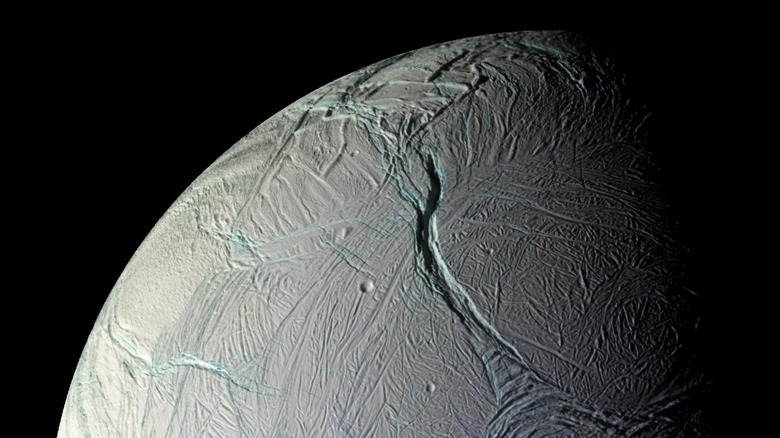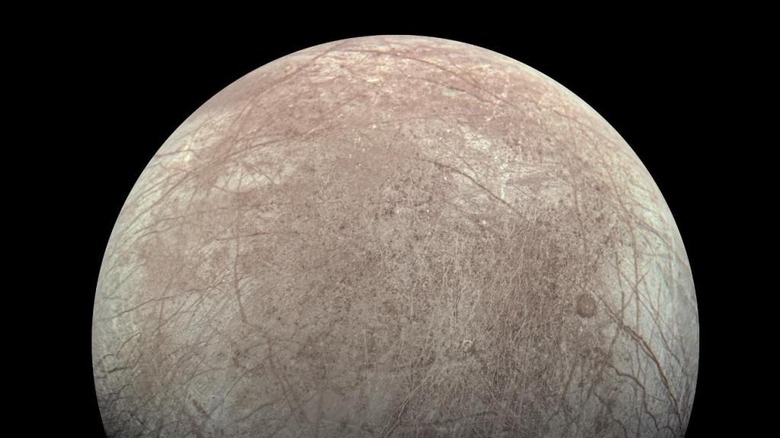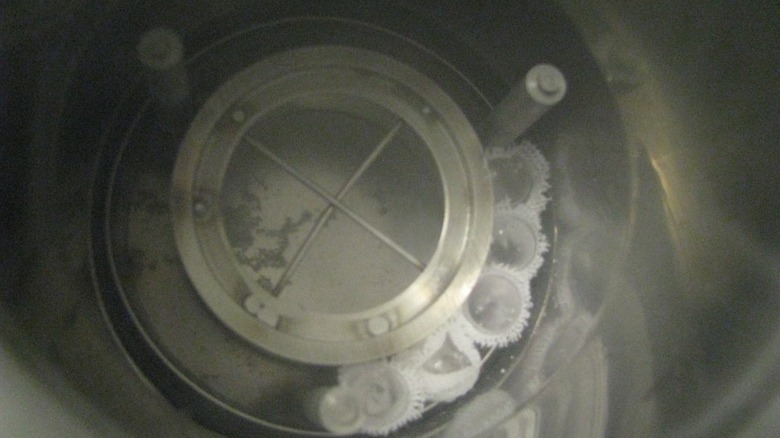Why NASA Thinks That Life Could Survive On Jupiter And Saturn's Icy Moons
When it comes to searching for places beyond Earth where life could potentially survive, scientists don't only look at planets. They also consider other bodies such as moons, which are also theoretically capable of supporting habitable environments. In fact, when looking for locations within the solar system where life could thrive, two of the most promising locations are Jupiter's moon, Europa, and Saturn's moon, Enceladus.
However, both of these moons are far away from the Sun, so they are very cold. They are both far too cold for liquid water to exist on their surfaces, and as far as we know, liquid water is essential for almost all forms of life. So, why are they considered promising? It's because they both have thick icy crusts that are miles deep — but beneath these crusts, they are thought to have liquid water oceans. Scientists have long wondered whether life could survive in these subsurface oceans, and new research from NASA published in 2024 shows that there are promising signs for habitability in both of these locations.
The research, published in the journal Astrobiology, looks at chemicals called organic molecules. These molecules, such as amino acids and nucleic acids, aren't direct evidence of life. But they are the building blocks which are required for life as we know it to form. Searching for these organic molecules is an important step in determining if life could ever exist in a distant location such as on these two moons.
Scientists aim to search icy moons for organic molecules
The first step in determining whether there is evidence of life on other planetary bodies is finding a means of detecting these organic molecules. Alexander Pavlov, of NASA's Goddard Space Flight Center, led a research team in trying to determine whether future robotic explorers would have to drill very deep to find any potential organic particles living beneath these icy crusts or whether they could look nearer the surface.
The good news for potential life hunters is that researchers found signatures of life survive relatively close to the surface of Europa. As Pavlov said in a NASA new story: "Based on our experiments, the 'safe' sampling depth for amino acids on Europa is almost 8 inches (around 20 centimeters) at high latitudes of the trailing hemisphere (hemisphere opposite to the direction of Europa's motion around Jupiter) in the area where the surface hasn't been disturbed much by meteorite impacts."
On Enceladus, the news is even better: The signatures could even survive right on the surface, so missions wouldn't have to dig through the icy crust at all. "These molecules will survive radiolysis (breakdown by radiation) at any location on the Enceladus surface less than a tenth of an inch (under a few millimeters) from the surface," Pavlov explained.
[Featured image by Kevin M. Gill via NASA | Cropped and scaled | CC BY-SA 3.0]
How do scientists test for signs of life?
To understand what would happen to signs of live on icy moons, the researchers looked at how different substances respond to ionizing radiation. Whereas we are protected from radiation by Earth's magnetosphere, there is a lot of radiation in space. Icy moons are bombarded by this radiation, which can destroy organic signs of life that the scientists want to look for.
In the new research, the team took samples of amino acids, dead bacteria, and ice, and chilled them to -321 degrees Fahrenheit. Then, they sealed the samples up with no air to simulate the kinds of conditions they would be exposed to on Enceladus or Europa. Afterward, they bombarded the samples with gamma rays and looked at how quickly the amino acids broke down under the radiation.
They found that the amino acids survived long enough to be detected in future missions. That indicates that the signs are promising for future missions to Europa or Enceladus to be able to search for life. In fact, NASA is already planning to launch spacecraft to Jupiter's moon, Europa, where evidence of persistent water vapor was discovered. NASA also found ingredients for life in the deep oceans of Enceladus, but future missions should be able to confirm whether or not any actual organic signatures are present.


